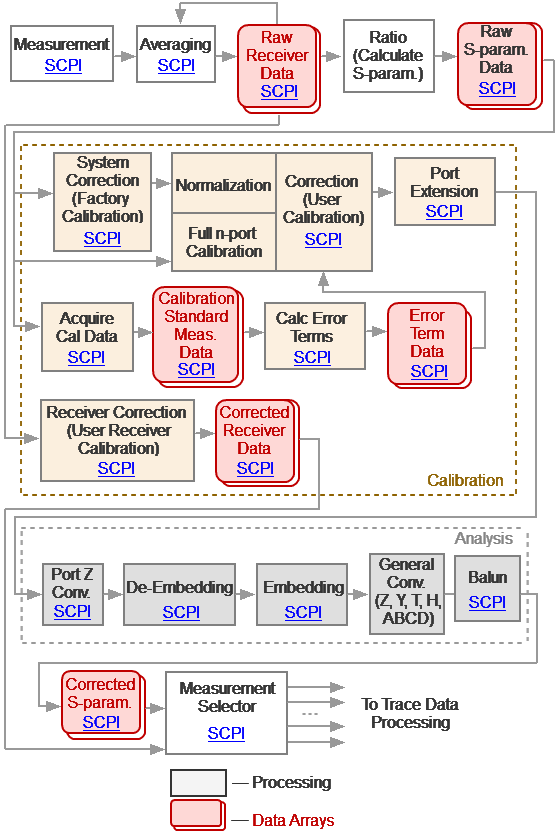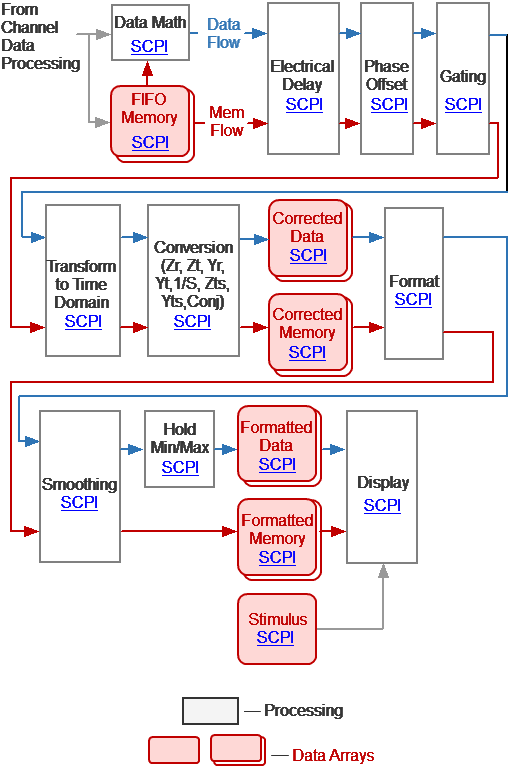This section describes the internal data arrays, access to them, as well as their position in the internal data flow of the Analyzer (See figure below). For a description of internal data processing, see Internal Data Processing. To search for SCPI commands related to arrays and processes, click "SCPI" in the figures below.
Channel Data Processing
All internal arrays of channel data processing (See figure below) contain the number of elements equal to twice the number of stimulus points. Each measurement point is represented in the array by a pair of adjacent elements. The odd elements of the array contain the real part of the data, the even ones contain the imaginary part of the data.
Channel Data Processing
Channel data processing of the Analyzer consists of the following arrays:
•Raw Receivers Data Arrays are obtained as a result of analog-to-digital conversion and digital filtering of analog signals received by the receivers. If averaging is enabled, then the array elements are averaged pointwise over N sweep cycles. Array data is available for reading using the SCPI command SENS:DATA:RAWD?.
•Raw S-param. Data Arrays are obtained by calculating the ratio of the signals two receivers. Array data is available for reading using the SCPI command SENS:DATA:RAWD?.
•Calibration Standard Meas. Data Arrays are temporary arrays that contain the results of the performed measurements of the calibration standards. Upon completion of the calibration process, after calculating the error terms, the arrays are cleared. Array data is available for reading or writing using the SCPI commands SENS:CORR:COLL:DATA:XXXX.
•Error Term Data Arrays are obtained as a result of processing measurements of calibration standards. Arrays are used in the correction when error terms are applied to the measured S-parameters. Array data is available for reading or writing using the SCPI command SENS:CORR:COEF.
note |
Error terms will be interpolated if, for example, the number of measurement points or stimulus settings for measurements and during calibration differ. In this case, the SENS:CORR:COEF command will read the interpolated data from the array. |
•Corrected Receivers Data Arrays are obtained as a result of the correction of the raw receiver data if the receivers are calibrated. This data is displayed on the screen if absolute measurements are selected. Array data is available for reading using the SCPI command SENS:DATA:CORR?
•Corrected S-param. Data Arrays are obtained from raw S-parameter arrays by performing the following operations: Correction, Port Extension, Port Z conversion, Embedding/De-embedding, General Conversion and Balun. Array data is readable using SCPI command SENS:DATA:CORR?
Trace Data Processing
The following data arrays: FIFO memory, Corrected Data, and Corrected Memory, Formatted Data, and Formatted Memory (See figure below) contain the number of elements equal to twice the number of stimulus points. Each measurement point is represented in the array by a pair of adjacent elements. The stimulus data array has the number of elements equal to the number of stimulus points.
In the following data arrays: FIFO memory, Corrected Data, and Corrected Memory, the odd array elements contain the real part of the data, the even ones contain the imaginary part of the data.
The arrays of Formatted Data and Formatted Memory, depending on the selected data format, contain data of various types (See table).
Trace Data Processing
•FIFO Memory is the queue of memory arrays type "first-in-first-out" basis. The next array is saved in FIFO as the result of activating the "Data-> Memory" function. The measurement (S-parameter or receiver data) of the associated trace is copied to the array. By default, the FIFO depth (size) is one, which means each trace has one associated memory array. When the FIFO function is enabled, the queue depth increases to eight. The memory can be used both for display and for math operations in conjunction with data. Active memory is selected for math operation with data if the FIFO depth is greater than one. SCPI commands for accessing this array are absent.
note |
Math memory operations are performed between the complex data of the current measurements and the memory, not between their formatted values (memory traces and data traces). |
note |
The memory arrays are processed in parallel with the measurement data array in subsequent processing stages. For example, the formatting has the same effect on the data trace as it does on the memory trace. In subsequent stages of processing, the number of memory arrays equal to the FIFO depth is used. |
•Corrected Data Array is obtained from the corrected S-parameter arrays or the corrected receiver data arrays as a result of performing the following operations: Trace Math, Electrical Delay, Phase Offset, Gating, Transform to Time Domain, and Conversion S-parameters. Arrays contain data that has been processed, except for formatting. Array data is available for reading or writing using the SCPI command CALC:DATA:SDAT.
•Corrected Memory Arrays is obtained from the Memory FIFO arrays as a result of performing the following operations: Electrical Delay, Phase Offset, Gating, Transform to Time Domain, and Conversion S-parameters. Arrays contain data that has been processed, with the exception of formatting. Array data is available for reading or writing using the SCPI command CALC:DATA:SMEM.
•Formatted Data Array is obtained by formatting the corrected data array and applying smoothing and hold operations to it. Arrays contain data that is ready to be displayed as a trace. Depending on the data format, the arrays contain two values for each measuring point (See table). Array data is available for reading or writing using the SCPI command CALC:DATA:FDAT.
•Formatted Memory Data Arrays are obtained by formatting corrected memory arrays and applying the smoothing operation to them. Arrays contain data that is ready to be displayed as a trace. Depending on the data format, the arrays contain two values for each measuring point (See table). Array data is available for reading or writing using the SCPI command CALC:DATA:FMEM.
•Stimulus Data Array contains the channel stimulus values for all measurement points. The data is available for reading using the SCPI command SENS:FREQ:DATA?.

